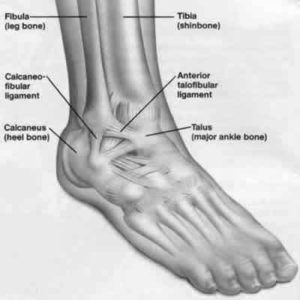Ankle instability is a condition characterised by the ankle ‘giving way’ or feeling wobbly and unreliable, particularly on uneven surfaces. There are two main ligaments that support the ankle. The outer ligaments, known as the lateral ligaments, have three components which stop the ankle from rolling and sliding forward. These ligaments are attached to the fibula (small bone next to the shin bone) and the talus (the ankle bone) and calcaneus (heel bone).An ankle sprain stretches and tears these ligaments and if the sprain doesn’t heal properly, ankle instability can develop.

The “giving way” takes place on the lateral, or outer side and will often occur during sports and walking. However, it can also happen while standing and may be accompanied by swelling, discomfort, tenderness and pain.
Chronic ankle instability usually develops following an ankle sprain that was not diagnosed properly or has not healed. An ankle sprain stretches and tears the connective tissues, known as the ligaments.When this occurs, small nerve sensors inside the ligament are often damaged. These nerve sensors, called the proprioceptive nerves, give your brain information about the position of your joints, allowing you to move and protect these joints. For example, nerve sensors in the arm and hand allow you to touch your nose when your eyes are closed.If these nerve endings are not working properly, your brain does not get reliable information and the muscles around your ankle may not work together properly. This causes your ankle to “give way”, often with minor stresses.Ankle instability makes you more prone to ankle sprains, which in turn exacerbate ankle instability. With each ankle sprain, the ligaments are increasingly weakened.
If your ankle feels unreliable and gives way repeatedly, or if you have recurring ankle sprains, it is recommended that you have a full assessment by a foot and ankle surgeon.Your foot will be examined for signs of swelling and tenderness. By stretching your ankle in different directions, the surgeon will be able to see whether the ligaments are abnormally weak. This is known as a stress view.The surgeon may take x-rays to check whether there is any damage to the ankle bones. An MRI scan may also be taken.
Treatment depends upon the severity of the ankle instability and the patient’s own activity levels.
Physiotherapy should be tried as the first treatment and is effective for many patients. Physiotherapy is based on retraining the damaged proprioceptive nerves, enabling them to respond to the movements of the ankle. The strength of muscles around the ankle will also be increased by exercises and activities. If your foot shape makes you prone to extra stress on the ankle ligaments, a moulded insole may be advised for your shoe to reduce these stresses.
Surgery may be considered if ankle instability fails to improve following non-surgical treatment, and depending on the degree of weakness in the ligaments. There are two main types of operation for ankle instability.